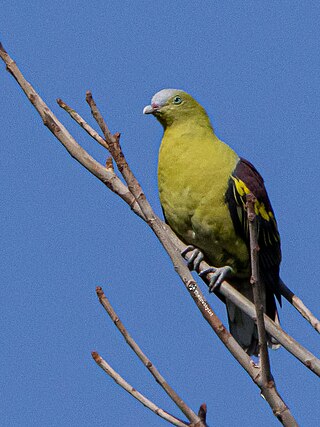
The Isabela oriole is a species of the oriole family endemic to Luzon in the Philippines. It is an oriole identified by its yellowish green plumage and a very large gray bill. This species was presumed to be extinct for many years until its rediscovery in December 1993 near Diffun, Quirino, and in Mansarong in September 1994. Additional sightings were made in San Mariano, Isabela. and Baggao, Cagayan Valley It It is found in moist lowland forest up to 440 masl. It is critically endangered with estimates of just 50 to 250 mature individuals remaining. It is threatened by habitat loss and hunting.

The scale-feathered malkoha is a species of cuckoo in the family Cuculidae. It is a spectacular looking bird with its white hood, red eyes and yellowish bill with a line of scaled feathers down from the bill and up over the crown, contrasted with rufous neck and back and a black lower body and tail. It is endemic to the Philippines found only in the islands of Luzon, Catanduanes and Marinduque. The species was named after the collector Hugh Cuming.

The Philippine leafbird is a species of bird in the family Chloropseidae. It is endemic to the Philippines. It is found in the islands of Mindanao, Leyte, Samar and Cebu. Its natural habitat is tropical moist lowland forest. It is threatened by habitat loss.

The Black shama is a species of bird in the family Muscicapidae. It is endemic to the island of Cebu, Philippines where it is known locally as "Siloy".

The New Caledonian cuckooshrike or New Caledonian cicadabird is a species of bird in the family Campephagidae. It is endemic to New Caledonia. Some taxonomists place this species in the genus Analisoma.

McGregor's cuckooshrike or the sharp-tailed cuckooshrike, is a species of bird in the family Campephagidae. It is endemic to Mindanao island on the Philippines. Its natural habitat is tropical moist montane forest. It is declining due to habitat loss.

The black cicadabird, also known as the New Guinea cuckooshrike or New Guinea cicadabird, is a species of bird in the family Campephagidae. It is found in the Aru Islands and New Guinea. Its natural habitats are subtropical or tropical moist lowland forest and subtropical or tropical mangrove forest.

The black-bibbed cicadabird or black-bibbed cuckooshrike is a species of bird in the family Campephagidae. It is endemic to the Philippines. The species is elusive and poorly known. This species has five subspecies that differ considerably in plummage, it is possible that this may actually be a species complex and consists of multiple species.

The black-bellied cuckooshrike or black-bellied cicadabird is a species of bird in the family Campephagidae. It is found in New Guinea. Its natural habitats are subtropical or tropical moist lowland forest and subtropical or tropical moist montane forest.

The white-winged cuckooshrike, also known as white-winged cicadabird or white-winged graybird, is a species of bird in the family Campephagidae. It is endemic to the Philippines found on the islands of Negros, Panay and formerly on Guimaras. Some taxonomists place this species in the genus Analisoma.

The striped flowerpecker is a species of bird in the family Dicaeidae. It is endemic to the Philippines. Its natural habitats are tropical moist lowland forest and tropical moist montane forest. It is part of the Thick-billed flowerpecker species complex and was formerly conspecific with it.

The pygmy flowerpecker is a species of bird in the family Dicaeidae. It is endemic to the Philippines.

The Philippine fairy-bluebird is a species of bird in the family Irenidae. It is endemic to the Philippines being found in the islands of Luzon, Mindanao, Samar and Bohol.

The black-and-white triller is a species of bird in the family Campephagidae. It is endemic to the Philippines. Its natural habitat is tropical moist lowland forests.

The white-lored oriole is a species of bird in the family Oriolidae. It is endemic to Luzon island (Philippines). It was formerly conspecific with the Philippine oriole but has since been separated as its own species. It was also formerly theorized that the critically endangered Isabela oriole was this species until it was rediscovered and proven otherwise.

The Philippine oriole or grey-throated oriole is a species of bird in the family Oriolidae. It is endemic to the Philippine found on Mindanao and most of the Visayan Islands.

The stripe-headed rhabdornis or stripe-headed creeper, also known as the stripe-sided rhabdornis, is a species of bird currently placed in the starling family, Sturnidae. It is endemic to the Philippines.

The lowland white-eye is a species of bird in the family Zosteropidae. It is near endemic to the northern part of the Philippines but is also found on the Taiwanese islands of Lüdao and Lanyu. Its natural habitat is tropical moist lowland forest, second growth and gardens.

The Philippine green pigeon is a pigeon in the genus Treron. It is endemic to the Philippines where it lives in the tropical moist lowland forests. It is part of the pompadour green pigeon complex which it was once conspecific with.

The Cebu boobook or Cebu hawk-owl is a species of owl in the family Strigidae. It is endemic to the Philippines. It was formerly considered a subspecies of the Philippine hawk-owl, but was reclassified in 2012, as voice and other data suggested placement in a distinct species.






















